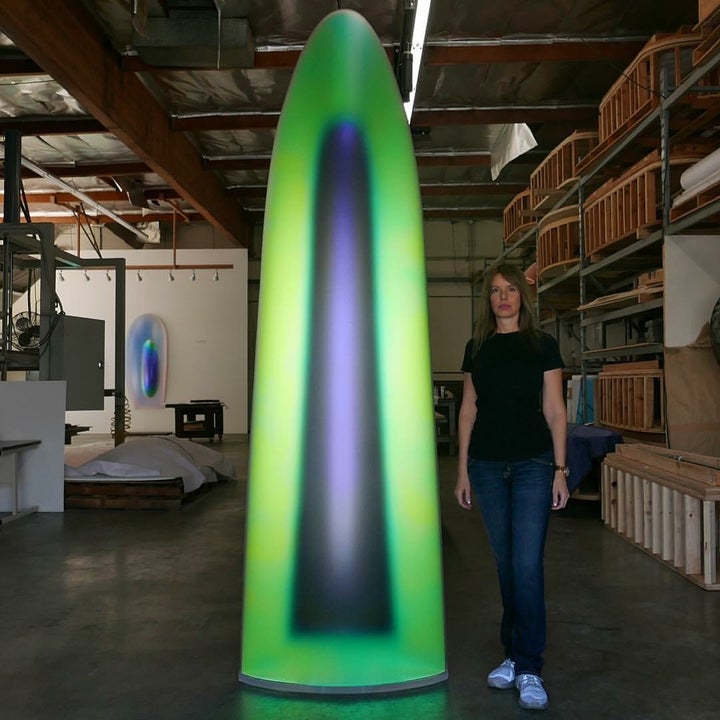
Introduction
Gisela Colon is an artist who is very conscious of her own historical lineage and position within an ongoing dialogue on light and space. She expands the dialogue on space composition by introducing a strong kinethesthetic element we cannot see until we physically inter-act with her sculptures, by moving around them to change the iridescent colors and mysterious forms which emanate from within. Her sculptures continually mutate which gives them a more organic quality than her predecessor’s work. Rather than a static lens looking out at an external world, her sculptures have a dynamic interior life which is set in motion by the viewer’s movements - recalling transformational processes we observe walking in nature.
This organic overlay expands the dialogue on minimalist concerns and use of industrial materials by introducing a more fluid quality, which also blurs sexual divisions. Colon is clearly paying an homage to her Light and Space and Minimalist predecessors but she adds a contemporary feminine twist to the dialogue. Her love of fecund shapes obviously relates to female organic forms like pods, cocoons and vessels that generate new life resembling pupa and larva. Colon was initially known for riffing on Craig Kauffman’s signature bubble forms, but came into her own by introducing these prenatal forms into his geometric economy - giving them a fertile interior life. But Colon makes a quantum leap with her free-standing monolith sculptures. These new works are a further play on gender fluidity because she transforms male phallic shapes into female noni shapes by combining diaphanous, internal floating forms, in a play on monumentality and delicacy - which recalls the sexual ambiguity of Louise Bourgeois’ witty sculptures.
Colon captures the élan of our times in her dynamic minimalist sculptures by demonstrating that sexuality is a spectrum and that as an artist she is not constrained by outmoded gender definitions. She owns her freedom to explore lessons she learns from studying both art and life itself. Colon embraces the legacy of her male predecessors and invigorates this history with her own instinctive understanding of female body rhythms. It is a powerful alchemy for creating sculpture which is unashamedly beautiful.
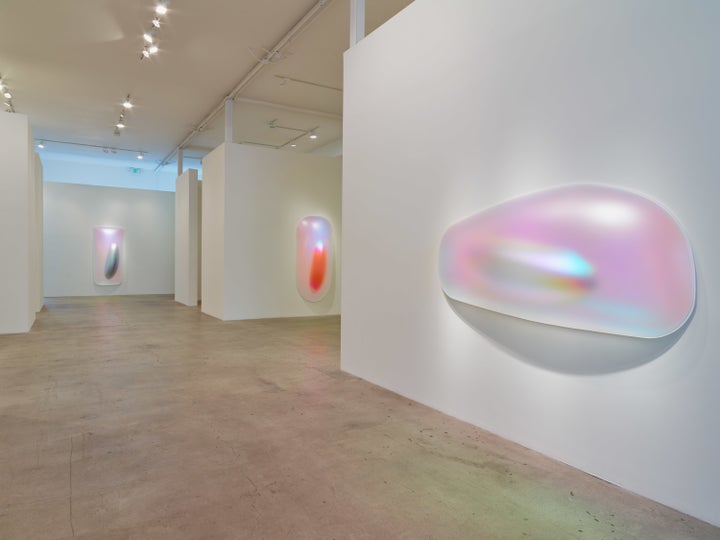
Interview with Gisela Colon
Barrie: The thing I find most interesting about your work is the kinesthetic quality. You expand the dialogue on space by earlier Light and Space and minimalist artists by putting greater emphasis on changes caused by the viewer’s body motion. Your work is not a lens looking out at the external world because it has an interior life we don’t see until we move around and inter-act with it physically.
Colon: Kinesthetics is a very interesting concept which has been around for generations. In the modernist era it goes back to artists such as, for example, Alexander Calder who made objects that had movement in them. However there is a difference between art that is kinetic (has inherent movement) and art that causes kinesthesia, meaning the movement around it generates vision. With respect to Minimalism, we see that East Coast Minimalism is somewhat different from West Coast minimalism in that regard. East Coast objects were what they were: autonomous objects that didn’t have any changing characteristics. Artists didn’t intend those works to interact with the outside environment - they are very self-contained. West Coast minimalist objects possess ephemeral qualities that result in ambiguous viewing experiences, yet the objects themselves were pretty static in terms of their actual physical characteristics. Thus any resulting kinesthesia didn’t reside in the object itself, but the viewing experience derived from a combination of object and environment. I am striving for a third factor of interplay. I’m focusing on making mutable objects that have inherently variable characteristics. My work is kinesthetic in the sense that movement actually causes physical and perceptual changes in the object. The body of the viewer can alter the color as their body affects the light flow. In addition, external conditions such as natural light versus artificial light, the orientation of the work, will also alter the object, allowing a kinesthetic quality above and beyond the concerns of classic Light and Space and Minimalism.
Barrie: The difference lies in the dynamic range of interior changes created by the viewer’s movements.
Colon: There are several layers to that interior change. One is color and then there is the form that is embedded inside the object. The color is very fluid and activated into a spectrum by light, which is the volatile factor in the equation. There are both external and internal forms that materialize and dematerialize depending on the position of the participant viewer.
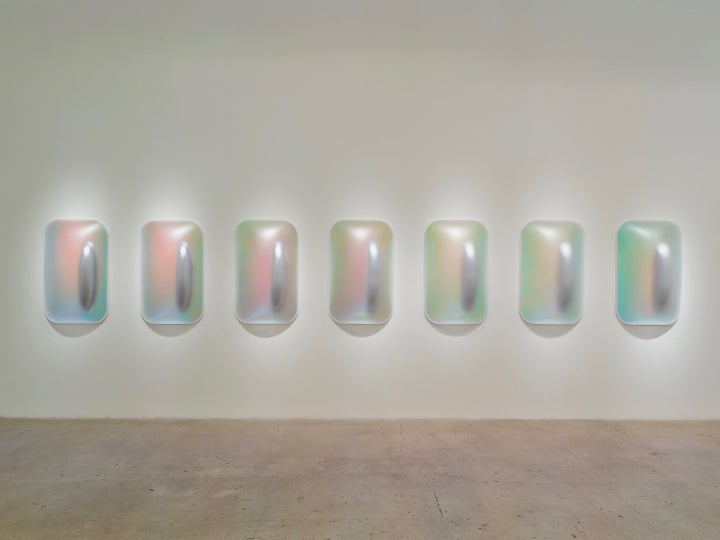
Barrie: The kinesthetic quality is most dynamic in Rectanguloid Progression, because the units change from iridescent colors to monochromatic silver as the viewer’s moves from one end of the spectrum to the other end. I think this multi-unit piece marks a major development in your work.
Colon: Yes, in addition to color and form, there is another dimension of kinesthetic quality because of the multiplicity of occurrences in the series of progressing forms receding and protruding. Multiplicity and seriality are inherent in our biological being because we want to repeat things over and over. In our society repetition is embedded in our sub-conscious to recursively review things.
Barrie: And they are having a conversation with each other.
Colon: Yes the effect is multiplied when you move across and around not one, but many iterations of the same form and configuration, causing each unit in the whole to have a slightly different variation, so when you see the whole together, the parts cause a realization or sensation of movement and change. You are seeing each one transform differently at the same time because your body’s vantage point is asymmetrical to the piece. I love that silver element inside - like a little silver worm - because it has an asymmetrical, amorphous quality that creates tension. One significant thing I learned from Judd is that polarity is important in the work, there is a need to create tension through a juxtaposition between durable and ephemeral qualities.
Barrie: Interestingly, you are also having a conversation with Donald Judd by introducing this silver into your work since we visited Chinati together last year. I watched how you loved moving around those silver aluminum boxes studying them from every angle. You absorb your influences in a subtle way because you internalize and then expand on them - making them your own while at the same time engaging in a dialogue with your predecessors.
Colon: Yes I started using the metallic materials after that trip. I started pursuing the aspect of neutrality which is more subdued in metallic materials than fluorescent colors but still has a life of it’s own because it is highly reflective. Judd’s 100 milled aluminum works and concrete boxes definitely have been influences. My first visit to Chinati was actually in 2014, and it had a big impact on me. This second visit last year 2016 brought a deeper understanding of movement as it relates to the object’s interaction with an outside environment. Robert Irwin's new seminal work Untitled (dawn to dusk) also had an influence on my increased use of metallics. His use of gradations of greys and whites are models of pristine subtleties.

Barrie: Another quality I see in your work that I don’t see in other Light and Space work is liquidity. There is a watery-ness to the work although it is solid.
Colon: I’ve always seen these works fluctuating between solid, liquid and gas. Almost like a biological imperative they have underneath. I’ve always said I draw my work at it’s most rudimentary level from life itself: from cells, organisms reproducing and from walking on earth. That organic quality is also biological from the way the planet is made up and it is our life essence.
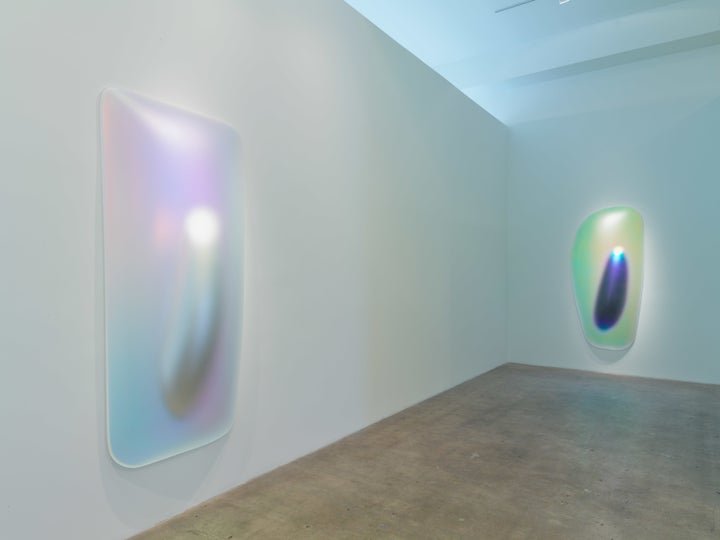
Barrie: There is also a strong female quality to your work. I don’t mean gender, which is culturally constructed. But in nature there are female forms and they are strong in your work. You engage in a dialogue with male artists you admire but from a different feminine sensibility of a woman drawn to organic vessel forms.
Colon: To define my work with the label of "female" or “feminine” would also be a construct. If you didn't know that the forms were created by a woman, perhaps that gloss of femaleness would not be seen. I'd rather converse in terms of "gender fluidity" which is a term that you coined in 2016. At the outset, foundationally, my work is not intended to be referential, it is an autonomous object devoid of meaning. Nevertheless, the forms can appear to the viewer as phallic or sexualized in certain ways. And they could be seen subjectively as possessing a female quality of generating life we see in vessels and forms within forms.
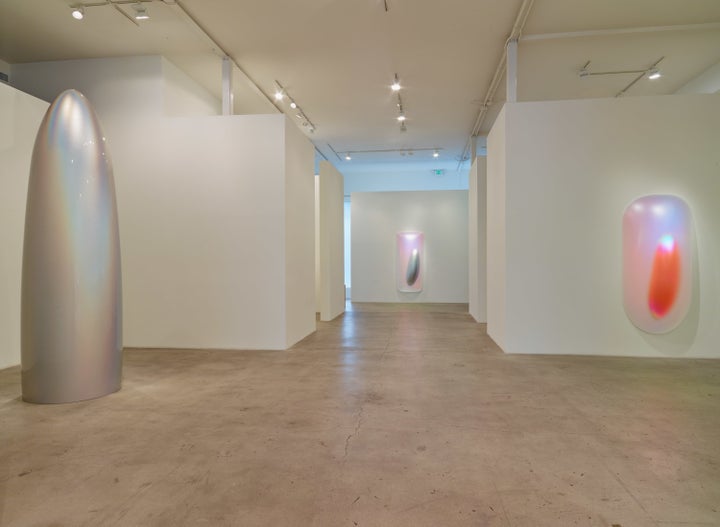
Barrie: It recalls the fecundity we see everywhere in nature: in pods and eggs. But when you make an obvious phallic shape like the Silver Monolith you combine a liquid quality which recalls the interior of a woman - like a noni. So you explore a sexual spectrum rather than a sexual dichotomy, which actually reflects current ideas about gender fluidity.
Colon: Yes that is correct. The work is fluidly on a spectrum; it can embody gradations of all those qualities. I made this big heavy massive piece and I wanted to finish it in the softest colors that disappear and color-shift, creating a contrast of strong and soft, sleek and hard, of masculine and feminine, ying and yang. It’s really about oscillations and transformations, not being fixed, static and determined, but rather fluidly liquid.
Barrie: So you play with the aesthetics of shapes that you enjoy, to create a spectrum of visual complexities.
Colon: The underlying reason is I was also trying to simplify form and take it to it’s real foundation. If you look at the pods you will see the silver forms floating inside. I thought what if I take that form out of the pod and made it an independent form that is singular, that stands for itself, that further eliminates extraneous elements and is even more minimal. That idea generated the creation of this Silver Monolith.
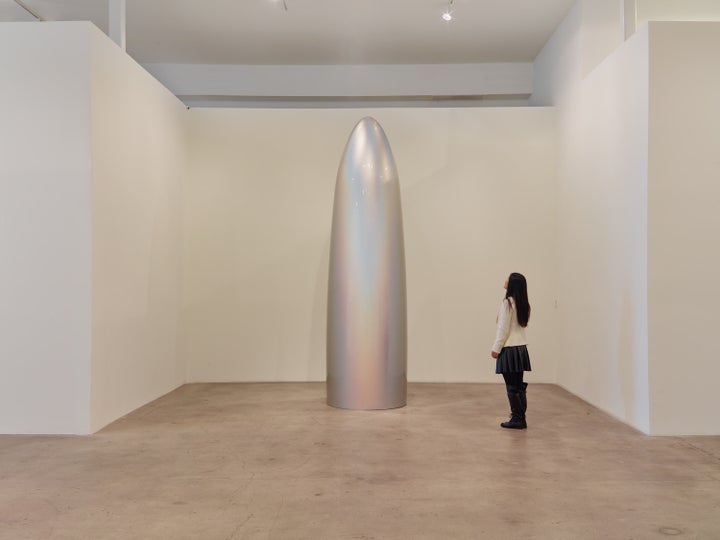
Barrie: Were you working on these two pieces at the same time?
Colon: Yes, they were simultaneous.
Barrie: It is interesting that you were simultaneously working on repetition and seriality in one work and singularity in another. You are really attracted to strong contrasts.
Colon: Yes, I wanted to examine both the concepts of multiplicity and also singularity, the idea of just one thing and seeking purity and clarity of form. To start with, the Silver Monolith is monochromatic which is a reduction in color composition. Since color-shift is a trademark quality of my work, my version of monochrome silver is also holographic when activated by light. It’s monochromatic yet in an equivocal way. Also the Silver Monolith form intentionally has no corners, no lines, no seams, it has no place to rest the eye. The tip is perfectly rounded. So you get this sleek uninterrupted purity of form. Then on the other side you have the multiple unit Rectanguloid Progression which is a recursive repetitive experience, yet they both have a common denominator, which is clarity. Clarity and purity of thought, to me is very important.
Barrie: Just as you blur gender lines you also blur the lines between art and nature.
Colon: Although they can feel organic, I also want them to have an industrial quality attached to them. This is in keeping with the minimalist philosophy that I embrace that I do not want the hand of the artist to be a visible element of the work. I am seeking a harmonious balance between contrasting aspects such as natural and artificial, organic and man-made, industrial and life-like.
Barrie: Or anything autobiographic or about being a woman. You deal with formalism but in a different way that is more organic.
Colon: I don’t want these sculptures imbued with anything personal. They are still minimalist objects which are industrial in nature, yet possess formal aspects that are derived from asymmetrical organic forms. Historically, I don’t think any other minimalist or light and space artist has used organicism as a basis of work. Their work is formally based on classic geometric forms, which have lines, edges, corners, or particular forms that have a defined end to them. I wanted to expand the academic dialogue by introducing a new idea.
Barrie: That nothing is just this or just that but always relativistic which creates compelling ambiguities.
Colon: I’ve always wanted a reason for something. I just didn’t want to make art out of nowhere. For a long time I studied minimalism and asked “How did this come into being?” Minimalism appealed to me because it is the very first truly American art. It didn’t look at pre-existing considerations and definitions set forth by European standards. I also became friends with minimalists like DeWain Valentine, Mary Corse, Peter Alexander, Helen Pashgian, Larry Bell. I didn’t want to just leap off without a context for the work. After minimalism, and the work of Robert Irwin, James Turrell, Donald Judd, amongst others, how can you do honest work after that? It is a really difficult proposition to make art that genuinely speaks to what it necessary after that, to what can be expanded after that. So I set about to pursue the creation of what I have termed the "conditional object" or the "non-specific object" which introduces the idea of the inherently mutable object, which might add something to the conversation.
Barrie: You have a very intellectual approach but it is not disembodied intellectualism because you transform the physicality of life on earth into life-like art rather than art-like art. You seem to draw from a wide range of experiences.
Colon: Yes, I combine things from my childhood in Puerto Rico: random chaos, the jungle and things that grow. As a very young child, for example, I studied Gauguin with my mother, who was a painter, and learned about his wild use of colors: his sky was purple, grass was yellow, his unnatural use of colors. I studied Picasso, Wilfredo Lam, and lots of other painters. I painted and created lots of art in my early years. Many things inside my psyche have come to germinate years later. Like drawing from studying op and kinetic artists from South America, like Carlos Cruz-Diez and Jesus Rafael Soto.
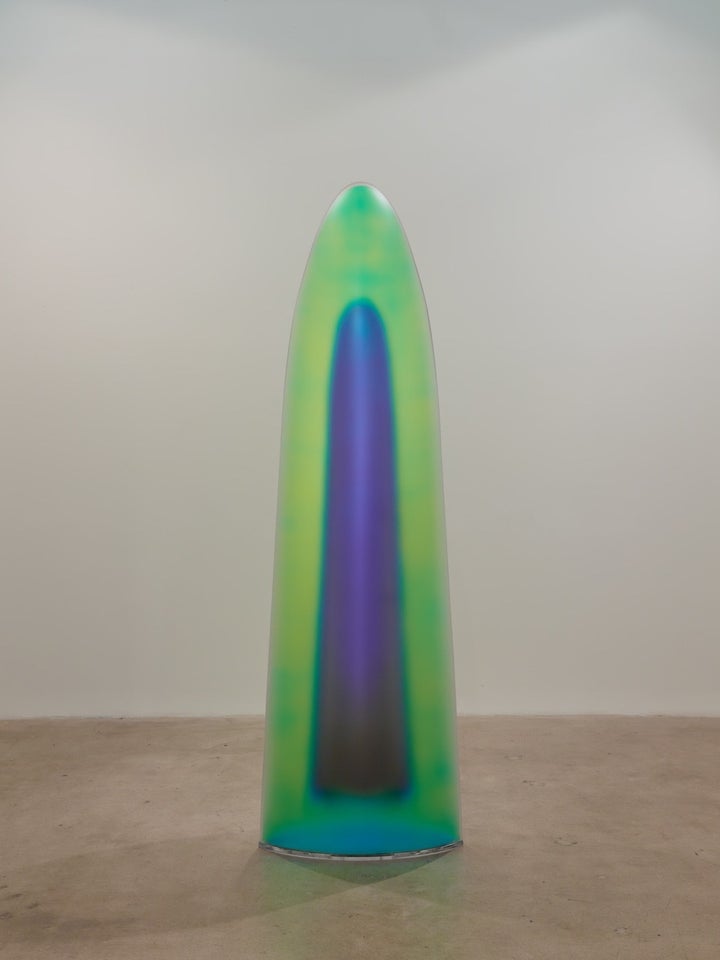
Barrie: What made you decide to move away from the wall to the free-standing pieces?
Colon: A desire to create more space, to allow more space around the object, to mediate space and generate movement around the object. It was also a step in the direction of further exploring simplicity of form, distillation of form, and clarity. Monolith Black, the first stand-alone work, was created so the internal form would end before the base of the piece. So it is hovering and looks as if it is floating. From the side the color disappears and the internal form turns to translucent matter. The bisecting black line is intentional because I wanted the eyes to separate. When you look at John McLaughlin paintings, one eye wants to go to one side and one eye wants to go to the other. There is a perceptual aspect to bisecting one piece into two hemispheres. There is a simultaneous separation and joining of form, again, an oscillation derived from movement.
Barrie: You are constantly distilling down.
Colon: But I’m still not just dealing with formal qualities because the work also involves transformation and change which is part of life itself and the human condition of existence.
Barrie: Every time I look at your work I see something I didn’t see before.
Colon: This is due to the inherent mutability of the object, causing that perceptual ambiguity, the appearance of change and transformation. Nothing is more real than the actual subjective experience of perception. It is a conduit to an experience, and hopefully that experience is one of aesthetic pleasure, or do I dare say the “b” word, “beauty,” an experience of beauty?
Barrie: I agree. Of course, we are bombarded with culturally-constructed superficial images of beauty in mass-media because advertisers understand how to manipulate us with their commercial definitions of beauty. Unfortunately many artists have abandoned the pursuit of beauty to pursue the abject and transgressive as though ugliness is more serious than beauty. But great artists, philosophers and even psychologists have always investigated beauty at a much deeper level to understand the power it has over us.
Colon: I believe aesthetics and the appreciation of beauty is something inherent in our genetic make up. We have a capacity biologically to crave beauty, to appreciate beauty, to want to be surrounded by an environment that possesses beauty. But again what is aesthetic beauty? It is of course, a subjective pursuit. For me there has to be some form of order, not necessarily a rational order, but a sequence, progression, formula of organizing the world around you, which yields balance, colors, forms, a conglomeration of aspects that come together to produce some form of harmony - something that the human eye can see and the entire body can sense and recognize as similar to what we see in untouched nature, or in untouched parts of the planet. The planet has life inside it, whether organic or inorganic. We live on this floating moving ball of Earth that is traveling through the stars, and has a life force that rules everything on this planet. We are part of that greater life force that wants us to seek aesthetic pleasure, to pursue beauty, balance and order.
Where: Diane Rosenstein Gallery. 831 Highland Ave, Los Angeles, CA 90038 + 323 462-2790
When: January 07- February 18, 2017
